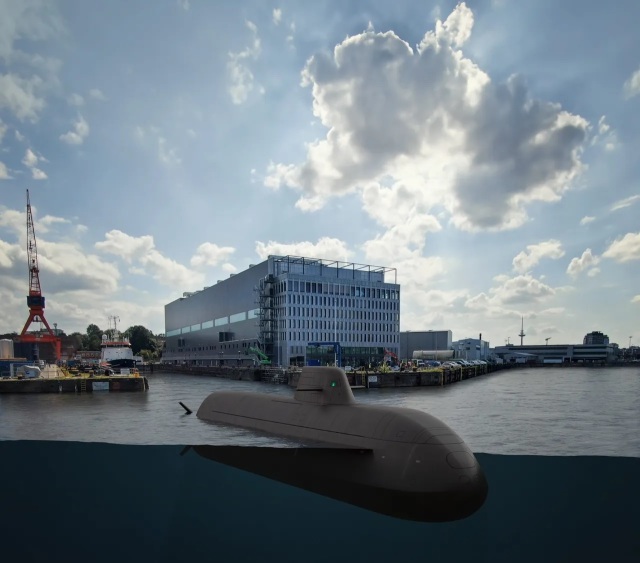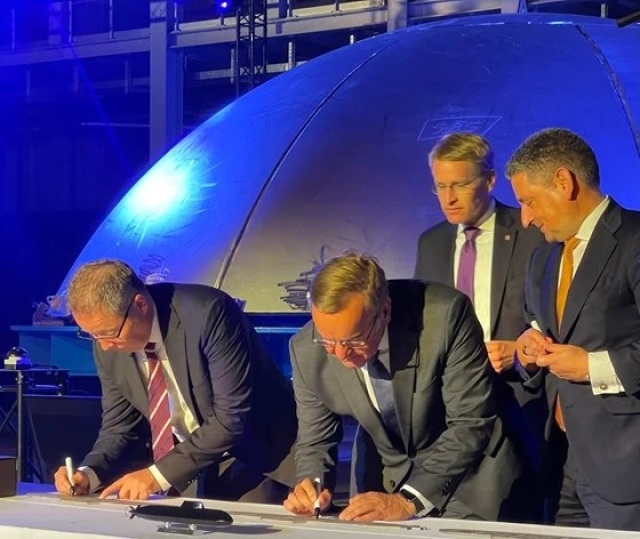On September 12, 2023, the Kieler Werft shipbuilding enterprise (formerly the Howaldtswerke-Deutsche Werft GmbH / HDW shipyard) located in Kiel, part of the German thyssenkrupp Marine Systems (TKMS), hosted an official ceremony to begin construction of the lead large non-nuclear submarine of the new 212CD project as part of a joint program between Germany and Norway. This program, within the framework of the 2017 bilateral agreement, provides for the construction of six submarines of the 212CD project - four for the Norwegian Navy and two for the German Navy. The lead boat, which has begun construction, is intended for the Norwegian fleet, which it should join in 2029. The ceremony of the start of its construction was held in the presence of German Defense Ministers Boris Pistorius and Norway Bjorn Arild Gram in a new production complex built at Kieler Werft TKMS.

The non-nuclear submarine of the 212CD project and the new production complex of the Kieler Werft shipbuilding enterprise of the German thyssenkrupp Marine Systems (TKMS) association (c) TKMS
Recall that in February 2017, the Norwegian and German Defense Ministries reached an agreement on the joint design, construction and purchase of new non-nuclear submarines of the 212CD (Common Design) project, which are an upgraded version of the non-nuclear submarines of the German 212A project (six units of which were built for the German Navy, and four for the Italian Navy). The intergovernmental agreement on the implementation of the joint program was signed in August 2017. Norway plans that four boats of the 212CD project will replace six German-built Ula submarines of the 210 project, commissioned in 1989-1992, in the Norwegian fleet. The German Navy is to receive two boats of the 212CD project in order to bring the number of its submarine forces to eight units.
The construction of all six boats of the 212CD project will be carried out in Kiel in a specially built new shipbuilding complex of the Kieler Werft TKMS shipyard (former Howaldtswerke-Deutsche Werft GmbH / HDW shipyard). The initial plans provided for the delivery of the first submarine of the Norwegian Navy in 2026, but gradually this period "crept to the right", and as a result, the lead boat is laid in the Keel only now, and the deadline for its transfer to the Norwegian Navy is considered to be 2029. According to the plans, three more boats should be handed over to the Norwegian Navy in 2030, 2031 and 2033, and the German Navy should receive its two boats (U-37 and U-38) in 2032 and 2034.
The total cost of the program for the purchase of four boats for the Norwegian Navy is currently estimated at 45 billion Norwegian kroner (4.4 billion euros), and for the purchase of two boats for the German Navy, the German Bundestag approved allocations in the amount of 2.74 billion euros in June 2021.
In July 2021, thyssenkrupp Marine Systems (TKMS, part of thyssenkrupp concern) signed a contract with the defense procurement departments of Norway (Forsvarsmateriell - FMA) and Germany (Bundesamt für Ausrüstung, Informationstechnik und Nutzung der Bundeswehr - BAAINBw) for the construction of six non-nuclear submarines of the 212CD project for the Norwegian and German navies as part of a joint program. The total cost of the contract for their construction is about 5.5 billion euros, which makes it the largest in the history of TKMS. TKMS has also signed a contract agreement on cooperation under this program with its main partner on the Norwegian side, the Norwegian Kongsberg Group. The basis for Kongsberg's participation in this program was the development and production of a new ORCCA automated control system for Project 212CD boats within the framework of the joint venture kta naval systems AS, created in 2017 by TKMS, its subsidiary Atlas Elektronik and Kongsberg Defense & Aerospace.
The submarine of the 212CD project is a further development of the 212A project, also having an air-independent power plant of the German model on hydrogen fuel cells, but at the same time having significantly larger dimensions - according to official TKMS data, the surface displacement of the 212CD project boat will be 2500 tons (cubic meters), the underwater displacement is 2800 tons, and the maximum length of 73 meters is against 1,524 tons of surface displacement and 57.2 meters of length in the last boats of the 212A project. The boats of the 212CD project will receive "stelsized" "diamond-shaped" hull contours for better sonar stealth, and will also be equipped with lithium-ion batteries (lithium-iron-phosphate type - LiFePO4, or LFP) developed under the auspices of TKMS, instead of lead-acid batteries used on the boats of the 212A project. Instead of one MTU 4000 diesel generator, two will be installed on the 212CD project boats.
Earlier it was reported about plans to equip the boats of the 212CD project with IDAS anti-aircraft guided missiles launched from torpedo tubes and a boat version of the Kongsberg NSM anti-ship missile, but currently there is no clear confirmation whether these boats will receive these promising systems, and when.

At the ceremony of the start of construction of the lead non-nuclear submarine of the 212CD project for the Norwegian Navy in the new production complex of the Kieler Werft shipbuilding enterprise of the German thyssenkrupp Marine Systems (TKMS) association. Kiel, 12.09.2023 (c) Norwegian Ministry of Defense
